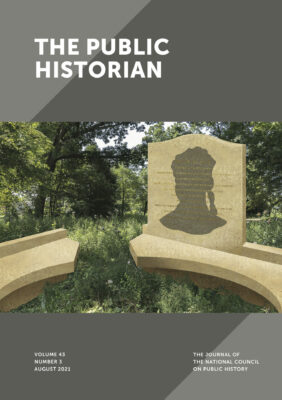Editor’s Corner: Community and Commemoration
03 August 2021 – Sarah H. Case
Editors’ Note: We publish the editor’s introduction to the August 2021 issue of The Public Historian here. The entire issue is available online to National Council on Public History members and to others with subscription access.
In this issue, we bring you three articles that deeply engage with one of the key subjects grappled with by public historians—the consideration of the role of the public not only as audience but also as interpreters of history. All three explore the complexity of community involvement and of integrating multiple ways of understanding, and producing, history. Additionally, the authors—specialists in museum studies, French, and anthropology—bring interdisciplinary perspectives to their work, perspectives that have proven invaluable in the development of our field.

Cover of Vol. 43, Issue 3, of “The Public Historian.” Artist Karyn Olivier’s rendering of the memorial to Dinah at Stenton, a historic house in Philadelphia. In this issue, Beth A. Uzwiak discusses Stenton’s community integration approach to creating a memorial to Dinah, a woman enslaved at the home in the 1700s. Cover image: Karyn Olivier
The issue opens with Cintia Velázquez Marroni’s examination of how two museums in Mexico City, the Galería de Historia Museo del Caracol and the Museo Nacional de la Revolución, interpret a controversial time in Mexican history, the dictatorship of President Porfirio Díaz in the late nineteenth and early twentieth centuries known as the Porfiriato. In Mexico, scholars have tended to dismiss museums, especially state-funded museums, as presenters of “official history”—a history lacking in complexity and supporting of the political views of the Partido Revolucionario Institucional (PRI), the party that held power for most of the twentieth century. In particular, to bolster PRI regime, museums, it is generally assumed, portray the Porfiriato (which the PRI replaced) as one-dimensionally negative. Velázquez finds, however, that museums present much more complex and nuanced interpretations of the Porfiriato than assumed by critics, emphasizing that critical history informs interpretation even at state-run institutions. Further, based on extensive interviews, she argues that visitors do not simply accept the narrative presented, but have their own, often critical, understanding of the national past.
In her examination of the Rhode Island Middle Passage Ceremonies and Port Marker Project, in which she participated, Karen de Bruin also considers how approaches to history and memory shape historical understanding in complex ways. Here, she candidly addresses why the effort to create a statewide project to commemorate the slave trade ultimately failed. She finds that although participants, representing Rhode Island’s academic and public history institutions, government organizations, and grassroots communities, all agreed on the importance of the project, that they had very different understandings of history, memory, and commemoration. On the one hand, the project “pitted a ‘traditional,’ ‘fact-based,’ and historically white approach to representing the past against a representation of the past rooted in the popular memories of marginalized communities,” but conflict also arose between two different descendant communities. Noting that studies of public history projects often celebrate success rather than address failure, de Bruin outlines important “lessons learned,” most significantly the importance of “scaffolded conversations” at the beginning of collaborations to create more awareness of different perspectives, methodologies, and goals.
Beth Uzwiak explores a more successful project, Inequality in Bronze, a two-year (2018–20) effort to reckon with the history of slavery at Stenton, a historic house museum in Philadelphia. Stenton took on the task of updating its memorialization of Dinah, an enslaved woman remembered for her role in allegedly saving the mansion from the British in 1777. The site created a process that went beyond community participation to community engagement, reaching out to its neighboring community and taking seriously the views expressed in an open conversation, including those skeptical of the historic site. As Uzwiak writes, “effective public history can be understood as method as much as product: a collective form of engagement and an excavation of biases—both personal and site-specific—that have shaped the presentation and interpretation of the past.” The project resulted in a new memorial by local artist Karen Olivier, part of which is featured on our cover. This issue also includes a review of “Remember My Name: Dinah’s Story,” a performance with two actors portraying Dinah followed by a panel discussion with the actors, screenwriter, and curator, reflecting our interest in reviewing more educational programming.
~Sarah H. Case, the editor of The Public Historian, earned her MA and Ph.D. in history at the University of California, Santa Barbara, where she is a continuing lecturer in history, teaching courses in public history, women’s history, and history of the South. She is the author of Leaders of Their Race: Educating Black and White Women in the New South (Illinois, 2017) and articles on women and education, reform, and commemoration.



